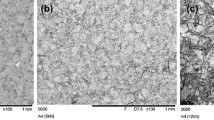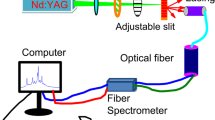Abstract
We have demonstrated the realization of a coherent vesicle random lasing (VRL) from the dye doped azobenzene polymer vesicles self-assembled in the tetrahydrofuran-water system, which contains a double-walled structure: a hydrophilic and hydrophobic part. The effect of the dye and azobenzene polymer concentration on the threshold of random laser has been researched. The threshold of random laser decreases with an increase in the concentration of the pyrromethene 597 (PM597) laser and azobenzene polymer. Moreover, the scattering of small size group vesicles is attributed to providing a loop to boost the coherent random laser through the Fourier transform analysis. Due to the vesicles having the similar structure with the cell, the generation of coherent random lasers from vesicles expand random lasers to the biomedicine filed.
Article PDF
Similar content being viewed by others
Avoid common mistakes on your manuscript.
References
V. S. Letokhov, “Stimulated emission of an ensemble of scattering particles with negative absorption,” ZhETF Prisma, 1967, 5(8): 262–265.
R. C. Polson and Z. V. Vardeny, “Random lasing in human tissues,” Applied Physics Letters, 2004, 85(7): 1289–1291.
B. Redding, M. A. Choma, and H. Cao, “Speckle-free laser imaging using random laser illumination,” Nature Photonics, 2012, 6(6): 355–359.
W. L. Zhang, Y. Y. Zhu, Y. J. Rao, Z. Wang, X. Jia, and H. Wu, “Random fiber laser formed by mixing dispersion compensated fiber and single mode fiber,” Optics Express, 2013, 21(7): 8544.
D. S. Wiersma, “Laser physics: the smallest random laser,” Nature, 2000, 406(6792): 132–133.
W. L. Zhang, Y. J. Rao, J. M. Zhu, Z. X. Yang, Z. N. Wang, and X. H. Jia, “Low threshold 2nd-order random lasing of a fiber laser with a half-opened cavity,” Optics Express, 2012, 20(13): 14400.
D. S. Wiersma, “The physics and applications of random lasers,” Nature Physics, 208, 4(5): 359–367.
Y. Ling, H. Cao, A. L. Burin, M. A. Ratner, X. Liu, and R. Chang, “Investigation of random lasers with resonant feedback,” Physical Review A, 2001, 64(6): 063808.
H. Cao, Y. G. Zhao, S. T. Ho, E. W. Seelig, Q. H. Wang, and R. Chang, “Random laser action in semiconductor powder,” Physical Review Letters, 1999, 82(11): 2278–2281.
D. S. Wiersma, M. P. Van Albada, and A. Lagendijk, “Coherent backscattering of light from amplifying random media,” Physical Review Letters, 1995, 75(9): 1739–1742.
H. Cao, “Lasing in random media,” Waves Random Complex, 2003, 13(13): R1–R39.
N. M. Lawandy, R. M. Balachandran, A. S. L. Gomes, and E. Sauvain, “Laser action in strongly scattering media,” Nature, 1994, 368(6470): 436–438.
S. Ferjani, A. De Luca, V. Barna, C. Versace, and G. Strangi, “Thermo-recurrent nematic random laser,” Optics Express, 2009, 17(3): 2042–2047.
Z. J. Hu, J. Y. Xia, Y. Y. Liang, J. X. Wen, E. M. Miao, J. J. Chen, et al., “Tunable random polymer fiber laser,” Optics Express, 2017, 25(15): 18421.
Z. J. Hu, H. J. Zheng, L. Wang, X. Tian, T. Wang, Q. Zhang, et al., “Random fiber laser of POSS solution-filled hollow optical fiber by end pumping,” Optics Communications, 2012, 285(19): 3967–3970.
Z. J. Hu, Q. Zhang, B. Miao, Q. Fu, G. Zou, Y. Chen, et al., “Coherent random fiber laser based on nanoparticles scattering in the extremely weakly scattering regime,” Physical Review Letters, 2012, 109(25): 253901.
Z. Tuzar and P. Kratochví, “Block and graft copolymer micelles in solution,” Advances in Colloid and Interface Science, 1976, 6(3): 201–232.
C. Price, “Developments in block copolymers,” London: Applied Science Publishers, 1982: 39.
J. Selb and Y. Gallot, “Developments in block copolymers,” London: Elsevier, 1985: 27.
L. Luo and A. Eisenberg, “Thermodynamic stabilization mechanism of block copolymer vesicles,” Journal of the American Chemical Society, 2001, 123(5): 1012.
E. Fattal, P. Couvreur, and C. Dubernet, “‘Smart’ delivery of antisense oligonucleotides by anionic pH-sensitive liposomes,” Advanced Drug Delivery Reviews, 2004, 56(7): 931–946.
W. J. Mulder, G. J. Strijkers, A. W. Griffioen, L. Van Bloois, G. Molema, G. Storm, et al., “A liposomal system for contrast-enhanced magnetic resonance imaging of molecular targets,” Bioconjugate Chemistry, 2004, 15(4): 799–806.
C. Nardin, J. Widmer, M. Winterhalter, and W. Meier, “Amphiphilic block copolymer nanocontainers as bioreactors,” The European Physical Journal E -Soft Matter, 2001, 4(4): 403–410.
M. Qi, G. Li, and Y. Gao, “Preparation and potential applications of polymer vesicles as drug carriers,” Ion Exchange & Adsorption, 2013, 29(5): 473–480.
J. J. L. M. Cornelissen, M. Fischer, N. A. J. M. Sommerdijk, and R. J. M. Nolte, “Helical superstructures from charged poly(styrene)-poly(isocyanodipeptide) block copolymers,” Science, 1998, 280(5368): 1427–1430.
S. J. Holder, N. A. J. M. Sommerdijk, S. J. Williams, R. J. M. Nolte, R. C. Hiorns, and R. G. Jones, “The first example of a poly(ethylene oxide)-poly (methylphenylsilane) amphiphilic block copolymer: vesicle formation in water,” Chemical Communications, 1998, 14: 1445–1446.
C. Nardin, T. Hirt, J. Leukel, and W. Meier, “Polymerized ABA triblock copolymer vesicles,” Langmuir, 2000, 16(3): 1035–1041.
H. Kukula, H. Schlaad, M. Antonietti, and S. Foerster, “The formation of polymer vesicles or “peptosomes” by polybutadiene-block-poly(l-glutamate)s in dilute aqueous solution,” Journal of the American Chemical Society, 2002, 124(8): 1658.
B. M. Discher, D. A. Hammer, F. S. Bates, and D. E. Discher, “Polymer vesicles in various media,” Current Opinion in Colloid & Interface Science, 2000, 5(1–2): 125–131.
A. A. Choucair, A. H. Kycia, and A. Eisenberg, “Kinetics of fusion of polystyrene-b-poly(acrylic acid) vesicles in solution,” Langmuir, 2003, 19(4): 1001–1008.
M. Irie, “Stimuli-responsive poly (N-isopropylacrylamide). Photo- and chemical-induced phase transitions,” Advances in Polymer Science, 1993, 110: 49–65.
B. L. Feringa, W. F. Jager, B. Delange, and E. W. Meiger, “Chiroptical molecular switch,” Journal of the American Chemical Society, 1991, 113(14): 5468–5470.
J. Eastoe and A. Vesperinas, “Self-assembly of light-sensitive surfactants,” Soft Matter, 2005, 1(5): 338–347.
W. Su, K. Han, Y. Luo, Z. Wang, Y. Li, and Q. Zhang, “Formation and photoresponsive properties of giant microvesicles assembled from azobenzene-containing amphiphilic diblock copolymers,” Macromolecular Chemistry & Physics, 2007, 208(9): 955–963.
W. Su, Y. Luo, Q. Yan, S. Wu, K. Han, Q. Zhang, et al., “Photoinduced fusion of micro-vesicles self-assembled from azobenzene-containing amphiphilic diblock copolymers,” Macromolecular Rapid Communications, 2007, 28(11): 1251–1256.
F. Lahoz, I. R. Martín, M. Urgellés, J. Marrero-Alonso, R. Marín, C. J. Saavedra, et al., “Random laser in biological tissues impregnated with a fluorescent anticancer drug,” Laser Physics Letters, 2015, 12(4): 045805.
M. Humar, A. Dobravec, X. Zhao, and S. H. Yun, “Biomaterial microlasers implantable in the cornea, skin, and blood,” Optica, 2017, 4(9): 1080.
M. C. Gather and S. H. Yun, “Single-cell biological lasers,” Nature Photonics, 2011, 5(7): 406–410.
Y. Wang, G. Shen, J. Gao, G. Zou, and Q. J. Zhang, “Dynamic orientation of azopyridine units within the shell of vesicles PNIPAM-b-PAzPyn copolymers,” Journal of Polymer Science Part B: Polymer Physics, 2015, 53(6): 415–421.
G. Y. Shen, G. S. Xue, J. Cai, G. Zou, Y. M. Li, and Q. J. Zhang, “Photo-induced reversible uniform to Janus shape change of vesicles composed of PNIPAM-b-PAzPy2,” Soft Matter, 2013, 9(8): 2512–2517.
Acknowledgement
The authors would like to thank the financial supports from the National Natural Science Foundation of China (Grant Nos. 11874012, 11404087, 11574070, 51771186, 11404086, 111874126, and 61501165); Fundamental Research Funds for the Central Universities (Grant Nos. JZ2019HGPA0099 and PA2018GDQT0006); Project of State Key Laboratory of Environment-friendly Energy Materials, Southwest University of Science and Technology (Grant No. 19fksy0111); Anhui Province Key Laboratory of Environment-friendly Polymer Materials (Grant No. KF2019001); the European Union’s Horizon 2020 Research and Innovation Programme under the Marie Skłodowska-Curie Grant Agreement (Grant No. 744817); Science and Technology Commission of Shanghai Municipality; China Postdoctoral Science Foundation (Grant Nos. 2015M571917 and 2017T100442).
Author information
Authors and Affiliations
Corresponding authors
Rights and permissions
Open Access This article is distributed under the terms of the Creative Commons Attribution 4.0 International License (http://creativecommons.org/licenses/by/4.0/), which permits unrestricted use, distribution, and reproduction in any medium, provided you give appropriate credit to the original author(s) and the source, provide a link to the Creative Commons license, and indicate if changes were made.
About this article
Cite this article
Li, Y., Xie, K., Zhang, X. et al. Coherent Random Lasing Realized in Polymer Vesicles. Photonic Sens 10, 254–264 (2020). https://doi.org/10.1007/s13320-019-0577-2
Received:
Revised:
Published:
Issue Date:
DOI: https://doi.org/10.1007/s13320-019-0577-2




